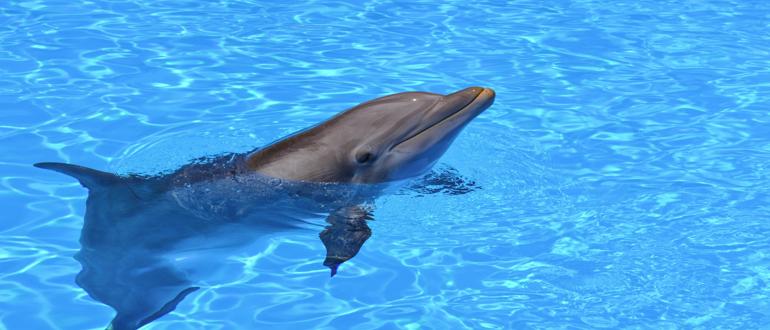
From the Kidero Hills of Tanzania to the Niassa Special Reserve in Mozambique, a small bird performs an ancient duet with humankind — a rudimentary conversation that includes guttural trills, grunts and whistles. The greater honeyguide lives up to its name after it is summoned, leading people to wild beehives. Along the journey, there is more communication. Once the hive is cracked open and the honey gathered, the bird swoops in to claim its reward: Beeswax. This rare example of interspecies communication, shaped by evolution and mutual benefit, may stretch back hundreds of thousands of years.
Now, researchers are hoping to forge a similar bond — this time with the highly social spotted dolphin — and are looking to tap artificial intelligence (AI) to accomplish that in much less time than it took humans to learn to “talk” with the Greater Honeyguide.
Google is collaborating with researchers at Georgia Tech and the Wild Dolphin Project (WDP) to learn the language of the spotted dolphin. Google has developed a large language model (LLM), called DolphinGemma, for that purpose.
Since 1985, the WDP has been observing a specific community of wild Atlantic spotted dolphins in the Bahamas. It is the world’s longest-running underwater dolphin research project and has collected hundreds of hours of recordings of dolphin sounds.
“This noninvasive, ‘In Their World, on Their Terms’ approach yields a rich, unique dataset: decades of underwater video and audio meticulously paired with individual dolphin identities, life histories and observed behaviors,” Google stated. The acoustic database has been uploaded to DolphinGemma.
The clicks, whistles and burst pulses elicit certain behaviors between the animals. The signature whistles, for example, may be linked to unique names, commonly used by mothers and calves to reunite. The burst-pulse squawks are often observed during fights. And the click buzzes are often used during courtship or when chasing sharks.
“Knowing the individual dolphins involved is crucial for accurate interpretation. The ultimate goal of this observational work is to understand the structure and potential meaning within these natural sound sequences — seeking patterns and rules that might indicate language. This long-term analysis of natural communication forms the bedrock of WDP’s research and provides essential context for any AI analysis,” Google stated.
DolphinGemma makes use of Google audio technologies, such as the SoundStream tokenizer, to replicate dolphin sounds.
“The journey to understanding dolphin communication is long, but the combination of dedicated field research by WDP, engineering expertise from Georgia Tech and the power of Google’s technology is opening exciting new possibilities,” Google stated. “We’re not just listening anymore. We’re beginning to understand the patterns within the sounds, paving the way for a future where the gap between human and dolphin communication might just get a little smaller.”
There does appear to be a connection between dolphins and humans, with many accounts of the animals coming to the aid of drowning swimmers or thwarting shark attacks. Their playful interaction with humans is well documented. The U.S. Navy has a Marine Mammal Program, which trains bottlenose dolphins to “detect, locate, mark and recover objects in harbors, coastal areas, and at depth in the open sea.”
“Dolphins naturally possess the most sophisticated sonar known to science,” stated the Naval Information Warfare Center Pacific, a high-tech sector of the Navy. “Mines and other potentially dangerous objects on the ocean floor that are difficult to detect with electronic sonar, especially in coastal shallows or cluttered harbors, are easily found by the dolphins. Both dolphins and sea lions have excellent low-light vision and underwater directional hearing that allow them to detect and track undersea targets, even in dark or murky waters. They can also dive hundreds of feet below the surface without risk of decompression sickness or the bends, like human divers. Someday it may be possible to complete these missions with underwater drones, but for now technology is no match for the animals.”
The collaboration between Google, the WDP and Georgia Tech is also seeking to teach the spotted dolphin a trick or two along the way.
“In addition to analyzing natural communication, WDP is also pursuing a distinct, parallel path: exploring potential two-way interaction using technology in the ocean. This effort led to the development of the CHAT (Cetacean Hearing Augmentation Telemetry) system, in partnership with Georgia Tech,” Google stated. “CHAT is an underwater computer designed not to directly decipher the dolphins’ complex natural language, but to establish a simpler, shared vocabulary. The concept first relies on associating novel, synthetic whistles (created by CHAT, distinct from natural dolphin sounds) with specific objects the dolphins enjoy, like sargassum, seagrass or scarves the researchers use. By demonstrating the system between humans, researchers hope the naturally curious dolphins will learn to mimic the whistles to request these items. Eventually, as more of the dolphins’ natural sounds are understood, they can also be added to the system.”
Scott Gilliland, a senior research scientist with the College of Computing at Georgia Tech, demonstrated how such a language tool would work in the water. Two marine biologists would wear the CHAT device on their forearms. The devices would play whistles into the water. The two researchers would also wear a vest that recognizes sounds emitted underwater. They would play a distinct whistle and then pass a scarf between them, hoping that the dolphins — keen observers — would pick up on the sound and playful action and begin to mimic the researchers.
“If that happens, that means that our dolphins have mimicked one word in our tiny made-up dolphin language,” Gilliland said.

